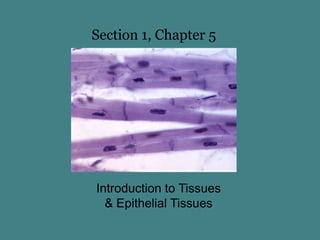
section 1, chapter 5
- 1. Section 1, Chapter 5 Introduction to Tissues & Epithelial Tissues
- 2. Tissues A Tissue is to a group of similar cells that carries out a specialized function. Histology is the science of tissues. examples of tissues
- 3. There are four broad categories of tissues Muscular tissue – specialized to contract Nervous tissue – conducts, senses, and stores information Epithelial tissue – forms coverings (skin) & linings (blood vessels) Connective tissues – support, transport, protect
- 4. Intercellular junctions Cells may be separated by a matrix or connected together by cellular junctions. 1. Tight Junction A tight junction fuses the cell membranes of adjacent cells together so molecules cannot move between the cells. Instead, they must move through the cells. Tight junctions prevent the passage of unwanted & harmful substances Examples: Blood Brain Barrier & Digestive Tract Cell 1 Interlocking membranes form tight junction between two cells Cell 2
- 5. Cellular Junctions 2. Desmosome desmosomes form “spot welds” between cells Provides structural support Examples of desmosomes are in the epidermis of the skin Cells connected by desmosomes
- 6. Cellular Junctions 3. Gap Junction Gap Junctions connect cells by protein ion channels that allow for cell-to-cell diffusion of ions Example of gap junctions are within the intercalated discs of cardiac muscle Intercalated discs of cardiac muscle are one type of gap junction.
- 7. Types of Tissues: Epithelial Tissue Epithelial Tissue: Epithelial tissue lines cavities, such as the digestive & respiratory tracts It also forms coverings, such as the skin Functions include protection, secretion, absorption, excretion
- 8. Epithelium: structure Epithelium is anchored to a layer of connective tissue, called the basement membrane. Epithelium has a basal surface that faces the basement membrane The free (apical) surface is exposed to the open space (lumen) Open space = lumen Basement membrane
- 9. Characteristics of Epithelial Tissue Epithelium consists of tightly packed cells They lack a blood supply, instead they receive nutrients by diffusion Epithelium readily divide, so they are continually replaced = rapid healing
- 10. Classifications of Epithelial Tissues Epithelium are classified by the layer of cells 1. Simple = Single layer of epithelial cells 2. Stratified = two or more layers of cells And they’re classified by the shape of cells 1. squamous = scale-like 2. cuboidal = cube-like shape 3. Columnar = tall cells
- 11. Simple Squamous Epithelium Single layer of flattened cells Functions include diffusion, filtration, and secretion Locations include: air sacs of lungs (alveoli) lining of capillaries and the walls of blood vessels glomerulus of kidneys. surface view of simple squamous ep. alveoli of lung
- 12. Simple Cuboidal Epithelium Single layer of cube-shaped cells Functions include secretion and absorption Locations include the lining and the ducts of some glands tubules within kidneys lumen cross-section of tubules in kidneys
- 13. Simple Columnar Epithelium Single layer of elongated cells and their nuclei appear as a single row Functions include absorption, secretion, or transport Often contain goblet cells Goblet cells secrete mucus onto apical surface may be ciliated, or have microvilli, or have no modifications on apical surface. columnar cells goblet cell microvilli “brush border”
- 14. Simple Columnar Epithelium Some simple columnar epithelium are covered with cilia on their free surface. Cilia beat constantly in a rhythmic motion to propel substances across the cell surface. Cilia propels the egg through uterine tube
- 15. Simple Columnar Epithelium Some simple columnar epithelium are covered with microvili on their free surface. Microvilli are extensions of the cell membrane that increases the surface area of a cell. Example of microvilli include the intestinal epithelium, where they increase the amount of contact each cell makes with food. Microvilli greatly enhance absorption of nutrients.
- 16. Pseudostratified Columnar Epithelium (PSCE) PSCE appear striated, but each cell touches the basement membrane. Usually ciliated Most PSCE contain goblet cells that secrete mucus Locations of PSCE include the lining of the respiratory tract: nasal cavity, pharynx, trachea, bronchi Functions: Mucus from goblet cells traps debris & cilia moves the mucus (and trapped debris) away from the lungs
- 17. Stratified Squamous Epithelium Several layers of cells = thick tissue Primary function is to protect underlying tissues from abrasion Superficial cells are squamous but the deeper cells are cuboidal or columnar May be keratinized or non-keratinized
- 18. Keratinized Stratified Squamous Epithelium Keratinized epithelium is found in the epidermis (outer layer) of skin Keratin is an insoluble protein that hardens and forms a protective coating. Cells accumulate keratin over time, so the older outermost cells of the epidermis are keratinized Stratified squamous epithelium of epidermis
- 19. Non-keratinized Stratified Squamous Epithelium Non-keratinized (moist) stratified squamous epithelium lines the esophagus, oral cavity, vagina, and anal canal. Apical surface Stratified squamous epithelium of vagina
- 20. Transitional Epithelium Transitional epithelium forms an expandable lining (Function: permit expansion) Locations include the inner layer of the urinary bladder & ureters The lining is several layers thick and the cells appear cuboidal when the urinary bladder is contracted, but only a few layers thick when the urinary bladder is distended and the cells appear squamous. empty urinary bladder distended urinary bladder
- 21. Glandular Epithelium Glandular epithelium is specialized to produce & secrete substances Glandular epithelium form glands Exocrine Glands Exocrine glands secretes substances through ducts onto an open surface Examples includes goblet cells, sweat glands, and mammary glands Duct of a sweat gland
- 22. Glandular Epithelium Endocrine Glands Endocrine glands secretes substances (hormones) directly into the blood stream. Examples includes the thyroid gland, pituitary gland, adrenal glands, ect. Follicles of thyroid gland are composed of simple cuboidal epithelium End of Section 1, Chapter 5